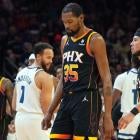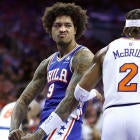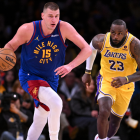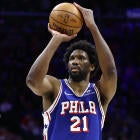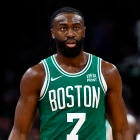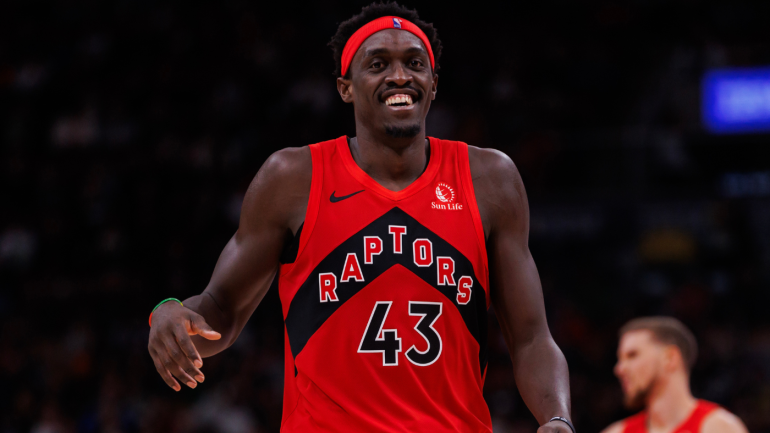
The Toronto Raptors already made one major trade this season when they dealt OG Anunoby to the New York Knicks for a package built around RJ Barrett and Immanuel Quickley, and on Wednesday they made their second significant move of the season. Two-time All-Star forward Pascal Siakam is headed to the Indiana Pacers in a deal built around three first-round picks. Here is the trade in its entirety:
- Pacers receive: Pascal Siakam, 2024 second-round pick (via Pelicans)
- Raptors receive: Bruce Brown, Jordan Nwora, Kira Lewis Jr., 2024 first-round pick (via Pacers), 2024 first-round pick (lesser of picks from Jazz/Clippers/Rockets/Thunder) and 2026 first-round pick (via Pacers, protected 1-4)
- Pelicans receive: Cash considerations
The Raptors and Pacers have been sensible trade partners for quite some time. Indiana has had a desperate need at forward for several years, and with all of their first-round picks at their disposal, they had the capacity to make the Raptors a bigger offer than other suitors like the Warriors, Mavericks, Kings and Hawks, who all owe at least one pick to other teams. As such, both the Pacers and Raptors grade reasonably well in the deal.
Raptors: B
Let's start with the obvious hang-up here: the Raptors didn't get the sort of premium asset they netted with Quickley in the Anunoby deal. It seems fairly clear at this point that such an asset was not available to them. That makes sense. Siakam is an impending free agent. He had a significant degree of control over his destination as a result, and no team was going to give up a cornerstone young player for a 29-year-old who doesn't make 3's and could walk after the season. All things considered, the Raptors did all right from a volume perspective.
The 2024 pick they got from Indiana is currently slated to fall somewhere between 17th and 19th, depending on tiebreakers. The pick coming from Oklahoma City is a bit less enticing—currently slated for 27th, and because of the heavy protections on it, it almost certainly won't get much better. Indiana's 2026 pick will likely fall somewhere between those two slots. With Tyrese Haliburton in place, the Pacers should be reasonably competitive so long as he stays healthy. Essentially, this means the Raptors are getting three mid-to-late first-rounders.
Fortunately, the Raptors have drafted exceedingly well in that range under Masai Ujiri and Bobby Webster. Between 2015 and 2017, they landed Delon Wright at No. 20, Siakam at No. 27 and Anunoby at No. 23. Their recent draft history isn't as strong, but their only late first-round pick in that window was No. 29 Malachi Flynn in 2020. Overall, their track record in that area of the draft is strong enough to suggest they'll at least hit on one of those picks. More pressingly, they've increased their chances of having another first-rounder, and a far higher one at that.
Toronto owes its 2024 first-round pick to San Antonio, but it's top-six protected. Right now, the 15-25 Raptors are tied with the Grizzlies for the No. 6 slot in the lottery. The injuries Memphis has endured suggest that the Grizzlies are likelier to finish in that No. 6 slot than the Raptors, but by moving Siakam, the Raptors have taken enough of a step back that finishing in sixth is at least somewhat feasible. Even if they land at No. 7, a bit of lottery luck isn't out of the question. After all, they moved up to No. 4 from the No. 7 slot in 2021 and landed Scottie Barnes.
And as matching salary goes, the Raptors could have done far worse than Bruce Brown. His $22 million salary is obviously a bit extreme for his production, but his team-option for next season gives the Raptors the choice to either get off of his salary entirely next season or work with him on a longer-term extension at a lower figure. They could even conceivably flip him at the deadline for a couple of second-round picks to another team with a big expiring deal. All in all, that makes this a decent return for Toronto. They didn't get a headliner in the deal, but they get three bites at the apple late in the first round without taking on any negative long-term salary.
Pacers: B
The Pacers had two critical needs coming into the trade deadline. The first was simply a natural forward. Aaron Nesmith (6-foot-5), Bennedict Mathurin (6-foot-5) and Buddy Hield (6-foot-4) have all played more than half of their minutes at forward this season, according to Basketball-Reference, despite being undersized for the position simply due to Indiana's roster construction. The second major need here was a No. 2 scorer. Eight Pacers average in double figures this season, but No. 2 scorer Myles Turner scores just 17.2 points per game. Championship contenders simply have more reliable secondary scorers.
Siakam obviously checks both boxes, and Indiana is uniquely positioned to maximize him. The Pacers rank seventh in 3-point attempts, 11th in 3-point percentage and second in pace. They have the spacing to mitigate his poor shooting and play so fast that he'll spend less time off of the ball in half-court settings than he would anywhere else. Siakam is not exactly the defensive stopper the Pacers hoped they were getting when they signed Brown, and he isn't even where he was a few years ago when he got All-Defense votes, but he'll immediately become one of the best defenders on the team. That's pretty significant for Indiana's No. 26-ranked defense. On the court, this is a good fit. It's going to make a good team better.
The bigger questions here relate to opportunity cost. From a pick perspective, that's small but possibly significant. By sending out two picks in 2024, Indiana's only Stepien Rule issues will come through the 2026 pick they'll owe Toronto after this. Owing a future pick limits the number of picks you can trade down the line, and with Haliburton in place, there will be other big-name players down the line that are interested in playing for the Pacers. Indiana could simply wait out that obligation and prepare to have a full complement of tradable picks starting in the summer of 2026, but things change fast in the NBA, and the Pacers aren't an especially aggressive organization. It's fair to assume for the time being that the Pacers have assembled the majority of the team that they plan to field for the next few years. Is this core championship-caliber? It's hard to say at this stage. How good will Mathurin be? Will any of the other youngsters pop? How much longer will Siakam's prime last?
The financial implications here are meaningful as well. Before this trade, the Pacers had roughly $100 million committed to nine players for next season against a projected $142 million cap. Assuming they were willing to let go of their own free agents, that would have positioned them for max cap space in free agency. In theory, they could have tried to sign Siakam outright over the summer. Getting him now allows Indiana a bit more flexibility in keeping role players like Hield, Obi Toppin and T.J. McConnell if they choose, but most teams would choose the three first-round picks over those players. Of course, Indianapolis has never exactly been a destination city in free agency, so the Pacers may not have been prepared to take that risk. Had he been traded to another contender, he almost certainly would have re-signed there.
Now he'll likely remain in Indiana on a new deal that approaches his max. The Pacers won't have much leverage here. Philadelphia is still slated for max cap space over the summer, and Detroit, another team with previous reported interest, just cleared extra cap space by trading Marvin Bagley. He will have other big offers if he actually does reach free agency. The Pacers are going to have to pay up to keep him. How will that deal age? It's hard to say, but a four-year pact would cover Siakam's age 30-33 seasons. That's a scary proposition for a scorer that doesn't make 3's.
Ultimately the deal accomplishes what the Pacers wanted to accomplish. They are a better team today than they were yesterday. The cap space they're sacrificing by going in for Siakam now probably couldn't have been spent in better ways when you consider how weak this summer's projected free-agent class will be, and they're only slightly encumbered from a draft pick perspective by making this deal. But there are risks built into this trade that prevent the Pacers from getting an "A" for their efforts. It's a smart risk, but a risk nonetheless.
Pelicans: B
Before the season began, we ranked the 10 players in the NBA likeliest to be traded this season. We've now seen four of those players moved before the deadline: Siakam, James Harden, P.J. Tucker and our surprise No. 1 pick, Kira Lewis Jr. Why was Lewis such an obvious trade candidate? Because the Pelicans entered the season roughly $3 million above the luxury tax line and Lewis makes roughly $5.7 million. He was their only way of getting below the line without touching their rotation, and doing so was necessary considering how expensive this team could get in the coming years. The Pelicans needed to duck below the tax line and they did so for a single second-round pick. That's a good, simple piece of business.















